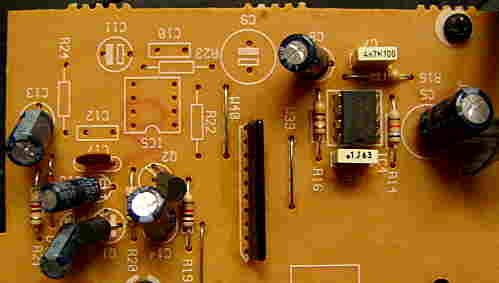This is the bigger brother of the small Bontempi GT 509. It has the same gritty digital zipper noise sounds and features 666 sound combinations. Unlike the latter it has 49 midsize keys with accompaniment section and you can select 6 different timbres for manual chords. Unfortunately it only accepts standard establishment chords.
Thanks to the longer keyboard it has now a real bass range with nicely sonorous timbres. Also this specimen (I bought mine used) emits rests of the same awful solvent chemical odour like the GT 509. This instrument sounds and behaves extremely similar like Bontempi GT 509, thus see there for details.
 |
 |
 |
 |
 The
PCB has empty solder holes for a 2nd identical power amplifier; apparently
the hardware was indeed designed in stereo, but the 2nd amp was omitted
to cut down costs. Strange is only that both amps would be connected with
the output of the same 8 bit DAC resistor array, but also my Bontempi
BS 2010 multiplexes the output from a single DAC to generate stereo
sound. Also the manual has a small note "stereo" in the technical data
section, despite this instrument in its actual form is mono.
The
PCB has empty solder holes for a 2nd identical power amplifier; apparently
the hardware was indeed designed in stereo, but the 2nd amp was omitted
to cut down costs. Strange is only that both amps would be connected with
the output of the same 8 bit DAC resistor array, but also my Bontempi
BS 2010 multiplexes the output from a single DAC to generate stereo
sound. Also the manual has a small note "stereo" in the technical data
section, despite this instrument in its actual form is mono.
The accompaniment accepts only standard establishment chords because its fingered chord mode ("free chord II") simply ignores any non- chord key combinations (the same stupid rubbish like with e.g. Yamaha PSS-390 and many other modern sound bank keyboards). Although there are 6 different accompaniment preset sounds selectable, they only take effect in manual chord mode (with rhythm off). The accompaniments of the rhythms only use always the same boring e-bass (or e-piano?) timbre.
A shorter variant of the Bontempi GT 759 (40 midsize keys, 1
speaker) was released as Bontempi GT 709 and GT 709N (different
panel colours). A fullsize variant (49 keys, 2 speakers, only 3 drumpads?)
was released as Bontempi GT 809. Bontempi originally had bought
this hardware technology from Farfisa, those released e.g. the variants
Farfisa
F404 (40 midsize keys, 1 speaker, no drumpads) and F498 (same
like Bontempi GT 809?). The modern successor of the Bontempi GT
759 is the Bontempi GT 770, which
has 100 preset "basic sounds" (instead of the only 36 of the GT 759), warmer
timbres and 12 note polyphony; the corresponding GT 709 successor is the
GT
720 (seen on eBay).
| removal of these screws voids warranty... | ||
 |
||
|
|